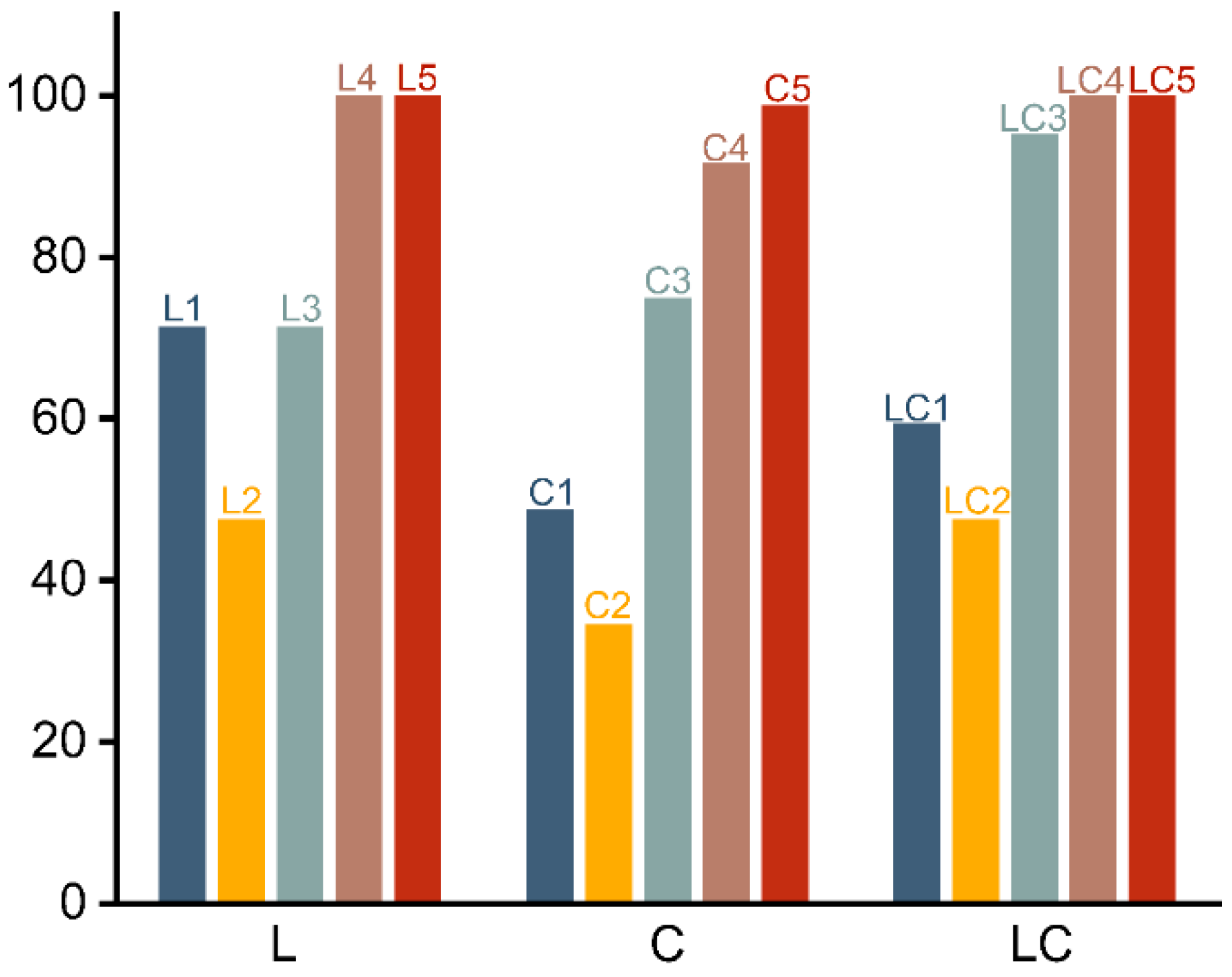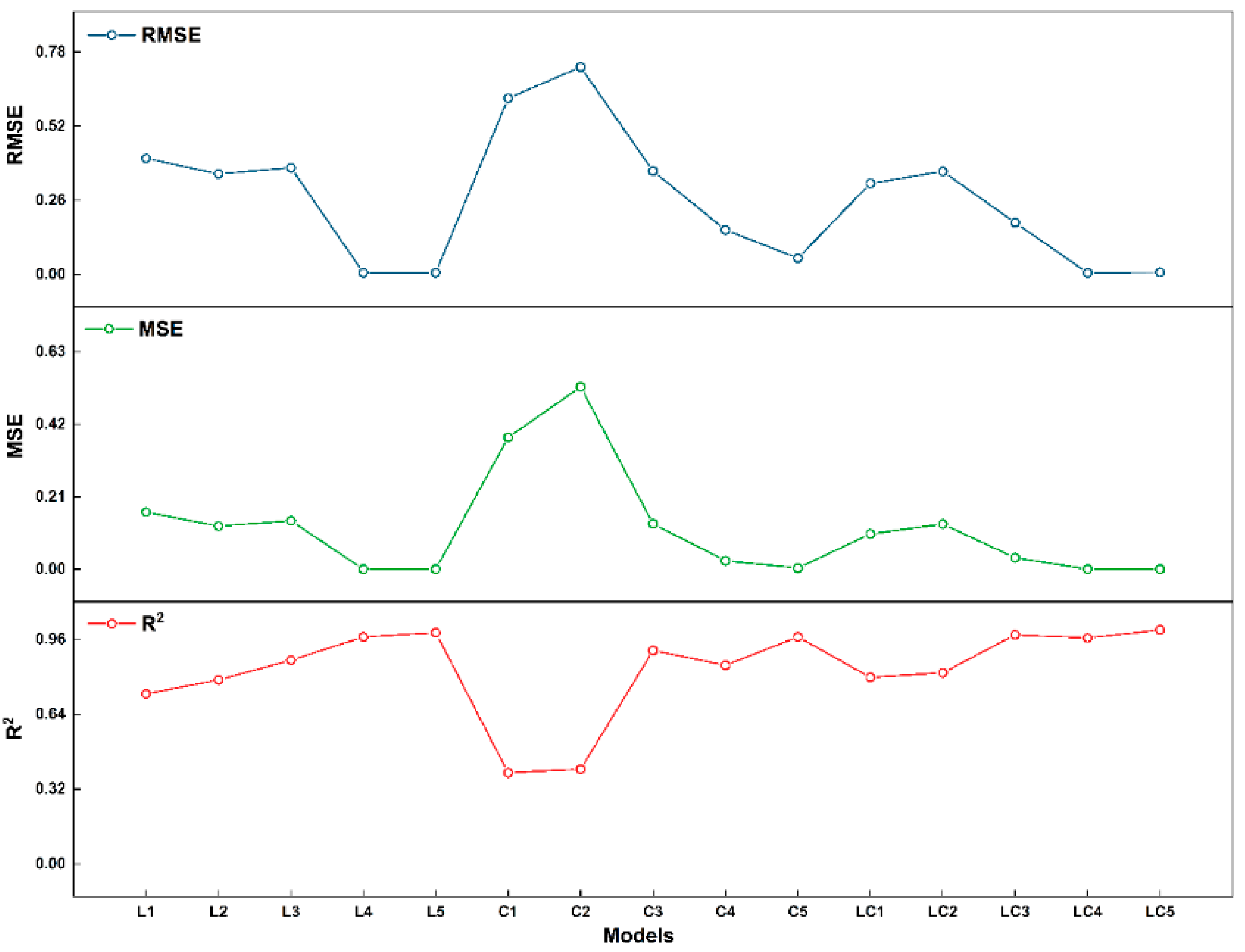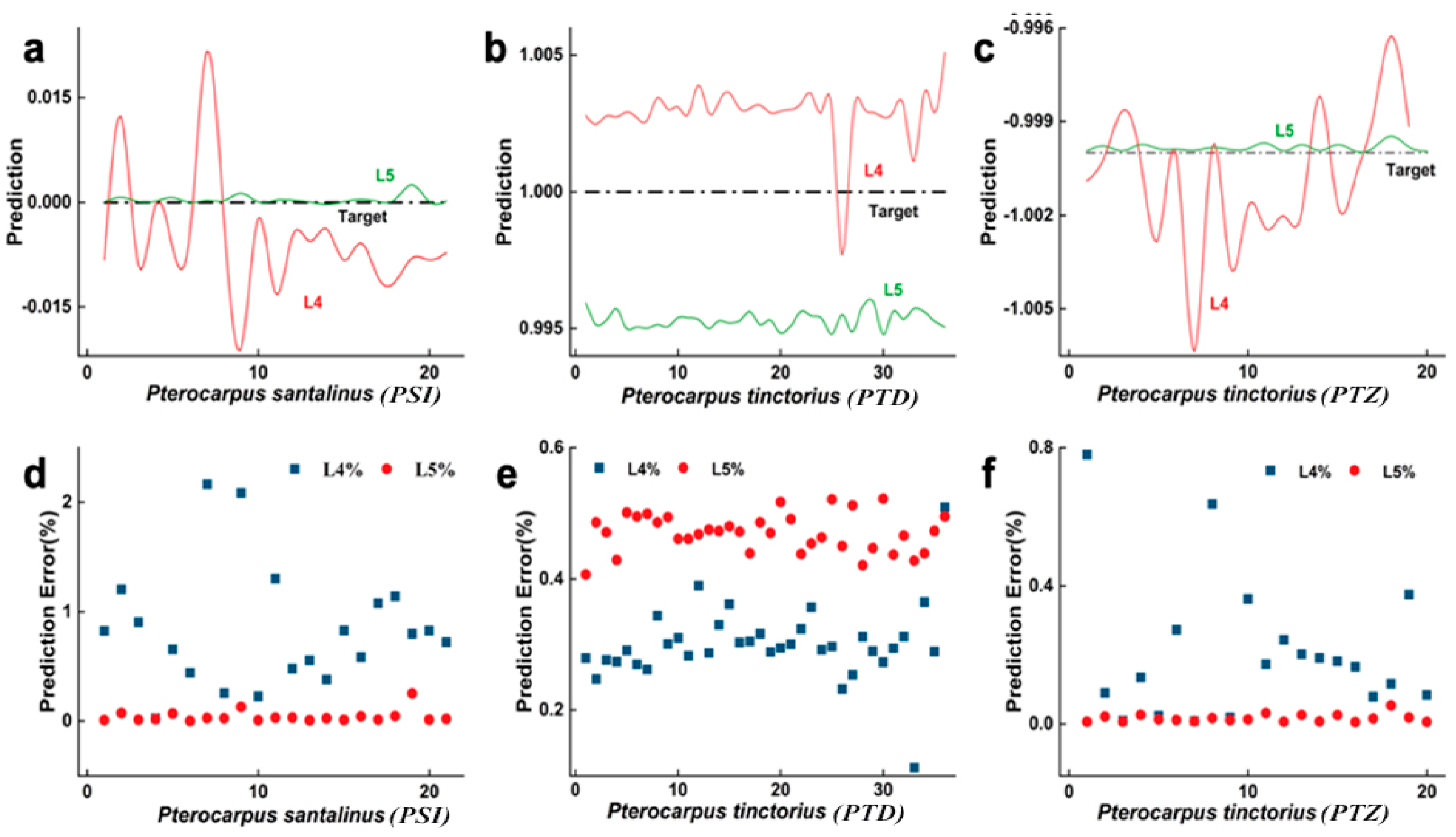Multi-Algorithm Feature Extraction from Dual Sections for the Recognition of Three African Redwoods
Abstract
1. Introduction
2. Materials and Methods
2.1. Data Acquisition
2.2. Feature Extraction Algorithm
2.3. BP Artificial Neural Networks
2.4. Evaluation Indicators of Models
2.5. Algorithm Parameter Specifications
| Method/Transformation | Parameters and Settings | Feature Extraction |
| Fast Fourier Transform (FFT) | Computed on 512 × 512-pixel ROIs. Frequency bins: 0 to Nyquist frequency (300 cycles/inch at 600 dpi). | Extracted radial (Srad) and angular (Sang) standard deviations from the magnitude spectrum [21]. |
| Gabor Transform | Filter bank: 4 scales × 6 orientations. Window size: 2 × 4 pixels (optimized for vessel detection). Spatial frequency: 16 cycles/mm (λ = 0.0625 mm). Orientation: θ = π/3 radians (60°). Gaussian envelope: σₓ = 1.5, σᵧ = 2.0 [22]. | Mean, contrast, entropy of response magnitudes. |
| Wavelet Transform (db2) | Decomposition levels: 2. Filter length: 4 coefficients. Subbands extracted: LL, LH, HL, HH at levels 1–2. Features: Standard deviations of coefficients across subbands [23]. | Standard deviations of coefficients across subbands [23]. |
| Gray-Level Co-Occurrence Matrix (GLCM) | Distance: δ = 1 pixel. Orientations: 0°, 45°, 90°, 135°. Gray levels: 64 (quantized from 8 bit). Window size: 32 × 32 pixels with 50% overlap. | Energy, contrast, correlation, entropy, inverse difference moment. |
| ANN Architecture | Hidden layers: 1–2 layers with 1–10 nodes . Activation: Hidden layers (logsig/tansig), output (purelin). Training: Levenberg–Marquardt (trainlm) with μ = 0.001. Stopping criteria: MSE < 10−5 or 1000 epochs. Validation: 70/15/15 train/val/test split. |
3. Results and Discussion
3.1. Analysis of the Models Trained by Each Section’s Feature Parameters
3.2. Analysis of WT and FPC Models Trained by Longitudinal-Section Features
3.3. Analysis of WT and FPC Models Trained by Transverse-Section Features
3.4. Analysis of WT and FPC Models Trained by Hybrid-Section Features
3.5. The Best Model of All
4. Conclusions
Author Contributions
Funding
Data Availability Statement
Conflicts of Interest
References
- Barmpoutis, P.; Dimitropoulos, K.; Barboutis, I.; Grammalidis, N.; Lefakis, P. Wood species recognition through multidimensional texture analysis. Comput. Electron. Agric. 2018, 144, 241–248. [Google Scholar] [CrossRef]
- Gasson, P. How precise can wood identification be? Wood anatomy’s role in support of the legal timber trade, especially cites. IAWA J. 2011, 32, 137–154. [Google Scholar] [CrossRef]
- Koch, G.; Haag, V. Control of Internationally Traded Timber—The Role of Macroscopic and Microscopic Wood Identification against Illegal Logging. J. Forensic Res. 2015, 6, 1000317. [Google Scholar] [CrossRef]
- Dormontt, E.E.; Boner, M.; Braun, B.; Breulmann, G.; Degen, B.; Espinoza, E.; Gardner, S.; Guillery, P.; Hermanson, J.C.; Koch, G.; et al. Forensic timber identification: It’s time to integrate disciplines to combat illegal logging. Biol. Conserv. 2015, 191, 790–798. [Google Scholar] [CrossRef]
- Brancalion, P.H.S.; De Almeida, D.R.A.; Vidal, E.; Molin, P.G.; Sontag, V.E.; Souza, S.E.X.F.; Schulze, M.D. Fake legal logging in the Brazilian amazon. Sci. Adv. 2018, 4, eaat1192. [Google Scholar] [CrossRef]
- Gomes, A.C.S.; Andrade, A.; Barreto-Silva, J.S.; Brenes-Arguedas, T.; López, D.C.; de Freitas, C.C.; Lang, C.; de Oliveira, A.A.; Pérez, A.J.; Perez, R.; et al. Local plant species delimitation in a highly diverse Amazonian forest: Do we all see the same species? J. Veg. Sci. 2013, 24, 70–79. [Google Scholar] [CrossRef]
- Goswami, G.; Mittal, P.; Majumdar, A.; Vatsa, M.; Singh, R. Group sparse representation based classification for multi-feature multimodal biometrics. Inf. Fusion 2016, 32, 3–12. [Google Scholar] [CrossRef]
- Wheeler, E.A.; Baas, P. Wood identification—A review. IAWA J. 1998, 19, 241–264. [Google Scholar] [CrossRef]
- Rosa da Silva, N.; Deklerck, V.; Baetens, J.M.; Van den Bulcke, J.; De Ridder, M.; Rousseau, M.; Bruno, O.M.; Beeckman, H.; Van Acker, J.; De Baets, B.; et al. Improved wood species identification based on multi-view imagery of the three anatomical planes. Plant Methods 2022, 18, 79. [Google Scholar] [CrossRef]
- Hwang, S.W.; Sugiyama, J. Computer vision-based wood identification and its expansion and contribution potentials in wood science: A review. Plant Methods 2021, 17, 47. [Google Scholar] [CrossRef]
- Ravindran, P.; Owens, F.C.; Wade, A.C.; Vega, P.; Montenegro, R.; Shmulsky, R.; Wiedenhoeft, A.C. Field-Deployable Computer Vision Wood Identification of Peruvian Timbers. Front. Plant Sci. 2021, 12, 647515. [Google Scholar] [CrossRef] [PubMed]
- Wu, F.; Gazo, R.; Haviarova, E.; Benes, B. Wood identification based on longitudinal section images by using deep learning. Wood Sci. Technol. 2021, 55, 553–563. [Google Scholar] [CrossRef]
- García, L.; García, F.; Palacios, P.; Romero, R.; Navarro, N. Artificial neural networks in wood identification: The case of two Juniperus species from the Canary Islands. IAWA J. 2009, 30, 87–94. [Google Scholar]
- Yusof, R.; Khalid, M.; Khairuddin, A.S.M. Fuzzy logic-based pre-classifier for tropical wood species recognition system. Mach. Vis. Appl. 2013, 24, 1589–1604. [Google Scholar] [CrossRef]
- Zamri, M.I.P.; Cordova, F.; Khairuddin, A.S.M.; Mokhtar, N.; Yusof, R. Tree species classification based on image analysis using Improved-Basic Gray Level Aura Matrix. Comput. Electron. Agric. 2016, 124, 227–233. [Google Scholar] [CrossRef]
- Avci, E.; Sengur, A.; Hanbay, D. An optimum feature extraction method for texture classification. Expert Syst. Appl. 2009, 36, 6036–6043. [Google Scholar] [CrossRef]
- Jinman, W.; Yanjie, Q.; Yongsheng, W. Analysis of wood anatomy characteristics by Fast Fourier Transfer image analysis. J. For. Res. 1997, 8, 243–245. [Google Scholar] [CrossRef]
- Tsai, D.M.; Lin, C.P.; Huang, K.T. Defect detection in coloured texture surfaces using Gabor filters. Imaging Sci. J. 2005, 53, 27–37. [Google Scholar] [CrossRef]
- Wen, C.-Y.; Chiu, S.-H.; Hsu, W.-S.; Hsu, G.-H. Defect Segmentation of Texture Images with Wavelet Transform and a Co-occurrence Matrix. Text. Res. J. 2001, 71, 743–749. [Google Scholar] [CrossRef]
- Savolainen, J. Matching method for mutated veneer sheet images using gray-level co-occurrence matrix features. Eur. J. Wood Wood Prod. 2023, 81, 1021–1031. [Google Scholar] [CrossRef]
- Liang, Y.; Cheng, F.; Jiang, Z.; Yuan, Q.; Sun, J. Concentrated load simulation analysis of bamboo-wood composite container floor. Eur. J. Wood Wood Prod. 2021, 79, 1183–1193. [Google Scholar] [CrossRef]
- Liang, S.Q.; Fu, F. Comparative study on three dynamic modulus of elasticity and static modulus of elasticity for Lodgepole pine lumber. J. For. Res. 2007, 18, 309–312. [Google Scholar] [CrossRef]
- Wang, H.-J.; Qi, H.-N.; Wang, X.F. A new Gabor based approach for wood recognition. Neurocomputing 2013, 116, 192–200. [Google Scholar] [CrossRef]
- Wang, L.; Li, L.; Qi, W.; Yang, H. Pattern recognition and size determination of internal wood defects based on wavelet neural networks. Comput. Electron. Agric. 2009, 69, 142–148. [Google Scholar] [CrossRef]
- Roy, S.S.; Roy, R.; Balas, V.E. Estimating heating load in buildings using multivariate adaptive regression splines, extreme learning machine, a hybrid model of MARS and ELM. Renew. Sustain. Energy Rev. 2018, 82, 4256–4268. [Google Scholar] [CrossRef]
- Dai, K.; Ji, F.; Bai, L.; Li, H. Research on Building Energy Consumption Prediction based on BP Neural Network. In Proceedings of the 2022 IEEE International Conference on Advances in Electrical Engineering and Computer Applications 2022, AEECA 2022, Dalian, China, 20–21 August 2022; pp. 476–480. [Google Scholar] [CrossRef]







| Section-Parameter Model | FFT Model | Gabor Model | GLCM Model | WTModel | Four-Parameter Combination (FPC) |
|---|---|---|---|---|---|
| Longitudinal section (L) | L1 | L2 | L3 | L4 | L5 |
| Transverse section (C) | C1 | C2 | C3 | C4 | C5 |
| Hybrid section (LC) | LC1 | LC2 | LC3 | LC4 | LC5 |
| Models | PSI (%) | PTD (%) | PTZ (%) | O (%) |
|---|---|---|---|---|
| L1 | 20.00 | 11.43 | 12.50 | 14.29 |
| L2 | 0.00 | 5.00 | 0.00 | 2.38 |
| L3 | 5.26 | 4.35 | 11.11 | 5.95 |
| L4 | 71.43 | 100.00 | 100.00 | 92.86 |
| L5 | 92.86 | 100.00 | 100.00 | 97.62 |
| C1 | 5.26 | 45.83 | 0.00 | 27.38 |
| C2 | 9.52 | 0.00 | 0.00 | 2.38 |
| C3 | 0.00 | 61.29 | 0.00 | 33.33 |
| C4 | 0.00 | 78.79 | 25.93 | 39.29 |
| C5 | 75.00 | 100.00 | 100.00 | 91.67 |
| LC1 | 7.41 | 18.18 | 0.00 | 9.52 |
| LC2 | 11.54 | 25.00 | 0.00 | 26.19 |
| LC3 | 69.57 | 97.83 | 100.00 | 90.48 |
| LC4 | 100.00 | 100.00 | 92.31 | 97.62 |
| LC5 | 92.00 | 100.00 | 93.75 | 96.43 |
Disclaimer/Publisher’s Note: The statements, opinions and data contained in all publications are solely those of the individual author(s) and contributor(s) and not of MDPI and/or the editor(s). MDPI and/or the editor(s) disclaim responsibility for any injury to people or property resulting from any ideas, methods, instructions or products referred to in the content. |
© 2025 by the authors. Licensee MDPI, Basel, Switzerland. This article is an open access article distributed under the terms and conditions of the Creative Commons Attribution (CC BY) license (https://creativecommons.org/licenses/by/4.0/).
Share and Cite
Sun, J.; Niu, J.; Xu, L.; Sun, J.; Zhao, L. Multi-Algorithm Feature Extraction from Dual Sections for the Recognition of Three African Redwoods. Forests 2025, 16, 1043. https://doi.org/10.3390/f16071043
Sun J, Niu J, Xu L, Sun J, Zhao L. Multi-Algorithm Feature Extraction from Dual Sections for the Recognition of Three African Redwoods. Forests. 2025; 16(7):1043. https://doi.org/10.3390/f16071043
Chicago/Turabian StyleSun, Jiawen, Jiashun Niu, Liren Xu, Jianping Sun, and Linhong Zhao. 2025. "Multi-Algorithm Feature Extraction from Dual Sections for the Recognition of Three African Redwoods" Forests 16, no. 7: 1043. https://doi.org/10.3390/f16071043
APA StyleSun, J., Niu, J., Xu, L., Sun, J., & Zhao, L. (2025). Multi-Algorithm Feature Extraction from Dual Sections for the Recognition of Three African Redwoods. Forests, 16(7), 1043. https://doi.org/10.3390/f16071043





